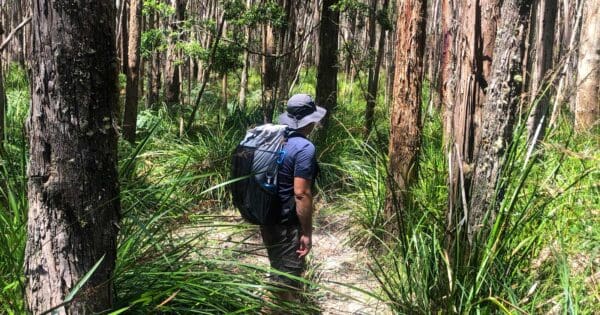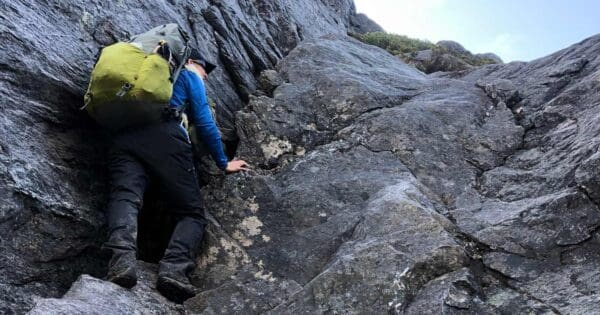Hiking poles, also known as trekking poles or walking sticks, are a popular accessory for hikers of all levels. These poles provide additional support and stability while trekking through rough or uneven terrain, reducing the strain on the legs and knees and improving balance and stability.
When selecting hiking poles, consider the material they are made from, as well as their adjustability and grip. Many poles are made from lightweight materials such as aluminum or carbon fiber, which can help reduce fatigue during long hikes. Adjustable poles can be customised to fit the height and stride of the hiker, while ergonomic grips can improve comfort and reduce hand fatigue.
With proper use, care and maintenance, hiking poles can last for many years. However, even the best poles can become damaged over time. If your hiking pole becomes bent, it is important to inspect the damage and take the necessary steps to repair or replace the pole as needed.
While I’ve been lucky to remain issue free, I’ve spoken with people and read online forums where people have called for help with a bent or broken trekking pole.
Before we get in to how to to straighten a bent hiking pole, let’s have a look at the different types of poles and materials they are made from.

Different types of hiking poles with respect to materials
Hiking poles are typically made of one of three materials: aluminum, carbon fiber, or titanium.
- Aluminum poles are the most common and affordable type. They are strong and durable, but some can also be heavy.
- Carbon fiber poles are lighter than aluminum poles, but they are also more expensive. They are also more susceptible to damage, so they should be handled with care. That being said, I’ve had set of carbon fibre poles for over ten years and have used them on day, overnight and multi-day hikes and never had an issue
- Titanium poles are the lightest and strongest type of hiking pole, but they are also the most expensive.
Why a hiking pole can bend
Hiking poles can bend for a variety of reasons, including:
- Incorrect use: Hiking poles can bend over time if they are not used correctly.
- Overuse: Hiking poles can bend over time if they are used heavily.
- Impact: If a hiking pole hits a rock or other hard object, or gets lodged under an obstacle, it can bend.
- Overloading: If a hiking pole is overloaded with too much weight, it can bend.
- Manufacturing defects: In rare cases, a hiking pole may be defective and bend easily.
Here’s a few tips to help prevent hiking pole damage:
- Use the correct size and type of hiking poles for your needs.
- Adjust the poles to the correct height before using them.
- Use the poles properly, following the manufacturer’s instructions.
- Be aware of your surroundings and avoid hazards such as rocks, roots, and holes in the ground.
By taking these precautions, you can help to reduce the risk of injury while using hiking poles.
The dangers of using a compromised hiking pole
Using a compromised hiking pole can be dangerous, as it can increase the risk of injury. A bent hiking pole is not as strong as a straight pole, and it is more likely to break. This can lead to a fall, which can result in serious injuries. A bent hiking pole can also be difficult to use properly. It may not provide the same level of support as a straight pole, and it may be more likely to get caught on rocks and other obstacles.
Here are some of the potential dangers:
- Loss of balance and stability. A compromised hiking pole may not be able to provide the same level of support and stability as an intact pole. This can lead to loss of balance and falls, especially on uneven or slippery terrain.
- Increased risk of injury. A compromised hiking pole may be more likely to break or fail, which could lead to injuries such as sprains, strains, and fractures.
- Damage to other equipment. A broken or damaged hiking pole could also damage other equipment, such as your backpack or tent.
For these reasons, it’s important to inspect your hiking poles regularly for signs of wear and tear. If you notice any cracks, bends, or other damage, it is best to repair or replace the pole immediately.

What to do with a bent hiking pole
If one of your hiking poles becomes bent, there are a few things you can do:
Inspect the damage. If the bend is minor and the pole is still structurally sound, you may be able to continue using it. However, if the bend is severe or the pole is cracked, it is best to replace it immediately.
Try to straighten the pole. If the bend is minor, you may be able to straighten the pole by hand. Be careful not to apply too much pressure, as this could damage the pole further. I’ve provided more detail on this methods, as well as alternative methods, below in case straightening by hand doesn’t work.
Use a splint. If the bend is more severe, you can use a splint to straighten the pole. A splint can be made from a variety of materials, such as a stick, a piece of metal, or even a hiking boot.
Replace the pole. If the pole is damaged beyond repair, you will need to replace it. Hiking poles are typically sold individually, so you can replace just the damaged pole without having to purchase a whole new set.
Here are some tips for dealing with a bent hiking pole:
- If you are able to continue using the bent pole, be careful not to put too much stress on it. Avoid using it on steep terrain or with a heavy backpack.
- If you are using a splint, be sure to check it regularly to make sure that it is still secure and that the pole is not bending further.
- If you are replacing the pole, make sure to purchase a pole that is the same length and material as the other pole. This will help to ensure that the poles work together properly.
There are a number of ways to straighten a bent hiking pole. The best method will depend on the severity of the bend and the type of material the pole is made of.
1. Bend it back by hand
If the bend is minor, you may be able to bend the pole back into shape by hand. To do this, grip the pole firmly at the bend and apply pressure in the opposite direction. Be careful not to over-bend the pole, as this could damage it.
2. Use a wrench or pliers
If the bend is more severe, you may need to use a wrench or pliers to help you bend the pole back into shape. To do this, place the wrench or pliers at the bend and apply pressure in the opposite direction. Be careful not to over-tighten the wrench or pliers, as this could damage the pole.
3. Heat it up
If the pole is made of aluminum, you can heat it up to make it more malleable. This will make it easier to bend the pole back into shape. To do this, use a hair dryer or heat gun to heat the pole at the bend. Once the pole is hot, bend it back into shape by hand or using a wrench or pliers. Be careful not to overheat the pole, as this could damage it.
4. Use a rubber mallet
If the pole is made of carbon fiber or titanium, you can use a rubber mallet to help you bend it back into shape. To do this, place the pole on a flat surface and tap the bend with the rubber mallet. Be careful not to hit the pole too hard, as this could damage it.
5. Use a pipe bender
If the bend is severe, you may need to use a pipe bender to straighten the pole. To do this, place the pole in the pipe bender and apply pressure until the pole is straight. Be careful not to over-bend the pole, as this could damage it. If you don’t have access to a pipe bender (I expect most people won’t) you can always check with a local plumber or steel works to see if they can help.
6. Use a vice or clamp
If you have a vice or clamp, you can use it to hold the pole in place while you bend it back into shape. To do this, clamp the pole at the bend and apply pressure in the opposite direction. Be careful not to over-tighten the vice or clamp, as this could damage the pole.
Seek professional help
If you are unable to straighten the pole yourself, you may need to seek professional help. A local outdoor gear shop or bicycle shop may be able to help you straighten the pole or replace the damaged section.
I hope you never have to worry about a bent hiking pole, but if you do, I hope these tips help.





